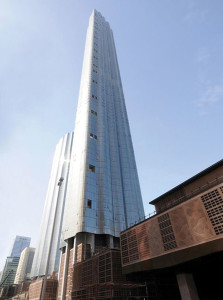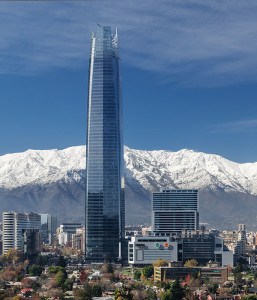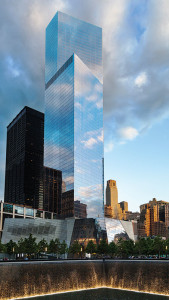2014 Was Impressive, and 2015 Will Be Even More So
If construction completion is used as the main basis of comparison, it is hard to conclude anything other than the global tall-building industry is burgeoning, seemingly despite emerging signs of global economic doldrums. The Council on Tall Buildings and Urban Habitat (CTBUH) has determined that 97 buildings of 200-meter (656-foot) height or greater were completed around the world in 2014 – a new record. This is a 20% increase from the previous record of 81, set in 2011. Not surprisingly, 60% of these 2014 buildings were in China.
Key Market Snapshots
- A total of 11 supertalls (buildings of 300 meters [984 feet] or higher) completed in 2014 – the highest annual total on record. Since 2010, 46 supertalls have been completed, representing 54% of the supertalls that currently exist (85). The number of 200-meter-plus (>656 feet) buildings in existence has hit 935, a 352% increase from 2000, when only 266 existed.
- The year 2014 was the “tallest year ever” by another measure: The sum of heights of all 200-meter-plus buildings completed across the globe in 2014 was 23,333 meters (76,552 feet) – setting another all-time record and breaking 2011’s previous record of 19,852 meters (65,131 feet).
- Asia’s dominance of the tall-building industry increased yet again in 2014. Seventy-four of the 97 buildings completed in 2014, or 76%, were in Asia.
- Once again, for the seventh year in a row, China completed the most 200-meter-plus buildings (58). This represents 60% of the global 2014 total, and a 61% increase over its previous record of 36 in 2013.
- The Philippines took second place with five completions, the United Arab Emirates and Qatar share position three with four completions each, and the United States, Japan, Indonesia and Canada tie for fourth, with three completions each.
- Japan marked its first entry into the supertall stakes with the completion of the 300-meter (984-foot) Abeno Harukas in Osaka, becoming the country’s tallest building.
- South America also welcomed its first supertall, the 300-meter (984-foot) Torre Costanera of Santiago, Chile, which was also the only building of 200 meters or greater to complete on the continent in 2014.
- Tianjin, China, was the city that completed the most 200-meter-plus buildings, with six. Chongqing, Wuhan, and Wuxi, China, along with Doha, Qatar, all tied for second place with four completions each.
- In 2014, 47 all-office buildings were completed (48% of the total), the largest total ever, versus 31 (38% of the total) in 2011, the previous record high.
- At 541 meters (1,775 feet), One World Trade Center was the tallest building to complete in 2014 and is now the world’s third-tallest building.

Burj Mohammmed Bin Rashid Tower, Abu Dhabi. Courtesy of Arabian Construction Company. Completed 2014, Height 1251 Feet, Owner: Aldar Properties, Architect: Foster + Partners, Structural Engineer: Halvorson and Partners.
Completions by Structural Material
A majority of tall buildings completed in 2014 were of composite construction – 52 out of 97 (54%), as compared to 24 out of 71 (34%) in 2013, while the number of buildings whose predominant structural material is concrete declined to 37 of 97 completed (34%) in 2014, from 43 of 71 (61%) in 2013.
All-steel continued its decline as a primary structural material, comprising only 5% of 2014’s 200-meter-plus completions and 13% of the world’s 100 tallest buildings, though it showed a slight uptick from 3% in 2013.
The World’s 100 Tallest Buildings: Impact of 2014
In 2014, the number of buildings entering the World’s 100 Tallest list was 13, one more than in 2013. The shortest building on the 100 Tallest list in 2013 was the Columbia Center, Seattle, at 284.4 meters (933.1 feet). In 2014, the shortest building became the 291.6-meter (956.7-foot) SEG Plaza in Shenzhen, having moved down the rung from number 87 to number 100.
The average height of buildings in the 100 Tallest list has thus increased to 350 meters (1,148 feet) in 2014 from 344 meters (1,129 feet) in 2013 – the figure in 2000 was 285 meters (935 feet).
The number of all-office towers in the 100 Tallest ranking continues to decline, with 39 all-office buildings, down from 42 in 2013. In context, as recently as 2000, 85 of the world’s 100 tallest buildings were all-office buildings.
In the 100 Tallest rankings, 39 buildings were composite construction, versus 36 in 2013. Despite the somewhat surprising increase in 2014, all-steel continued its decline as a primary structural material, comprising only five of 2014’s completions and 13 of the world’s 100 tallest buildings.

Torre Costanera, Santiago, Chile. Courtesy of Pablo Blanco Barro. Completed 2014, Height 984 Feet, Owner: Cencosud, Architect: Pelli Clarke Pelli, Structural Engineer: Rene Lagos Engineers.
Analysis
What can be made of this skyscraper surge? It could very well be that pent-up demand has returned to real-estate markets after a lull during the recession. Now that six years have passed since the global economic crisis/recession began in 2008, and given the long gestation and construction periods common to tall buildings, we are almost certainly seeing the results of a post-recessionary recovery.
Clearly, the Chinese juggernaut has not yet run out of steam. The country continues to see new 200-meter-plus completions in cities that previously had few or no such buildings, indicating that the massive plan to urbanize the country – requiring the urban relocation of some 250 million people – is underway. Its effects have begun to percolate into smaller regional cities beyond the first tier of Beijing, Shanghai, Guangzhou, Shenzhen, and Hong Kong. It is tempting, but dangerous, to take this as an undiluted sign of economic health, as the Chinese national and regional governments are principal stakeholders in many of these projects, and the “cause and effect” of the situation is not always clear. Is the government subsidizing tall buildings in order to attract businesses, and in anticipation of future masses, or are business and population needs organically driving growth?
The other major trend that would seem to justify further analysis is the increase in the number of all-office buildings, something that has not happened since the previous record year of 200-meter-plus completions across the board that occurred in 2011. The use of all-steel structures also increased slightly, which is counter to the overall trend of a steep decline since 2000. These 2014 figures are likely correlated.
The reason most office skyscrapers were historically made of steel is due to the spanning capabilities that steel affords the large, column-free spaces office tenants desired. But in the past decade, the use of composite construction, such as concrete-encased steel – most often working in conjunction with a concrete core – has risen with the increasing number of mixed-use buildings, and has provided the flexibility needed to accommodate all kinds of uses in one building. On its face, then, the small uptick in all-steel use in 2014 seems somewhat anomalous.
The number of all-steel cases is small enough to analyze as a group. All of the buildings have an office component, but two are mixed-use. Three of the five buildings completed are in Japan, which has extremely
high seismic requirements. The methods used to satisfy those requirements, such as base isolation and in-plane dampers, are easier to implement in steel. Also, steel has inherent flexural properties superior to that of concrete. The Cathay Life Xinyi A3 building in Taiwan is an office building in a high seismic zone as well. London’s Leadenhall Building, which entirely consists of office space for lease, had many particular site constraints that resulted in prefabrication being selected as the optimal construction method. Steel lends itself to the lifting and adjustment requirements of prefabrication, of course, and the project’s architect, Rogers Stirk Harbour + Partners, is widely known for its use of expressive steel exoskeletons in its work.

4 World Trade Center New York, NY. Courtesy of Fadi Asmar / LERA. Completed 2014, Height 977 Feet, Owner: Silverstein Properties, Architect: Maki and Assoc. / Adamson Assoc., Structural Engineer: Leslie E. Robertson Asssoc.
Trend-Watching
If anything, 2015 will be more active than 2014 and, indeed, any year previous. We currently project the completion of between 105 and 130 buildings of 200 meters’ height or greater, eight to 15 of which will be supertalls, and one of which will be a megatall – Shanghai Tower. Once again, China is expected to lead by a wide margin. China is on track to complete or top out 106 buildings of 200 meters or greater – that’s 86% of the low-range estimate (105) and 72% of the high-end estimate (130).
Here are some of the developments that will be making headlines in 2015:
Global
The US Department of Agriculture’s $2 million Tall Wood Building Prize Competition closed in February 2015 and, as of press time, the agency was considering technical proposals. The winning proposal team will go on to construct a wood building based on their design at least 24 meters (79 feet) in height. It’s looking like 2015 will be a critical year in the development of this new/old building technology. Plans for tall wood buildings have been announced in Vienna and Stockholm, while a project in Bergen, Norway is under construction. To capture all the great learning that is happening now in this field, CTBUH has formed a Tall Timber Working Group.
Changsha
Brushing off the apparent cancellation of its plan to build the world’s next tallest building (220 stories, 838 meters [2,749 feet]) out of prefabricated modules in a matter of months, the Broad Sustainable Building company finished a 57-story skyscraper using the same techniques in March 2015 – in 19 days – a stunning achievement.
Dubai
The long-planned Burj 2020 is back in action, according to CTBUH insiders. In late 2014, shortlisted architecture-engineering teams were being interviewed, making the claimed start of construction in 2015 seem plausible. If the 660-meter (2,165-foot) tower’s developers want to keep its original plan to have the highest observation deck, it will have to top the Burj Khalifa’s 555.7-meter (1,823-foot) perch.
Las Vegas
The erstwhile Harmon Hotel, a planned 47-story building, was stopped in 2008, having completed only 26 stories, after it was determined to be structurally unsound due to construction defects. The deconstruction began in June of 2014, and should complete by June 2015. The traditional Vegas-style implosion was eschewed, due to its proximity to the surrounding $8.5 billion CityCenter.
London
The beleaguered Pinnacle, a mere “stump” since 2011 due to the recession, was promised another lease on life under PLP Architecture and new owners Axa/Lipton Rogers in late 2014. In February, it was revealed that the unfinished twisting skyscraper would be demolished and replaced in a $480 million plan. The new building is more rectilinear in form, and will be called 22 Bishopsgate when it opens in 2018.
Moscow
The burgeoning Moscow-City complex has begun to pick up pace, after several economy-related delays and at least one fire. The Vostok Tower, at 373 meters (1,224 feet) the higher of the two Federation Towers, will also become the tallest building in Europe in 2015.
Shanghai
The 632-meter (2,073-foot) Shanghai Tower will complete by mid-year, becoming the tallest building in China and the world’s second-tallest building. The project is also highly anticipated due to its extensive use of double-skin façades and skygardens.▪
